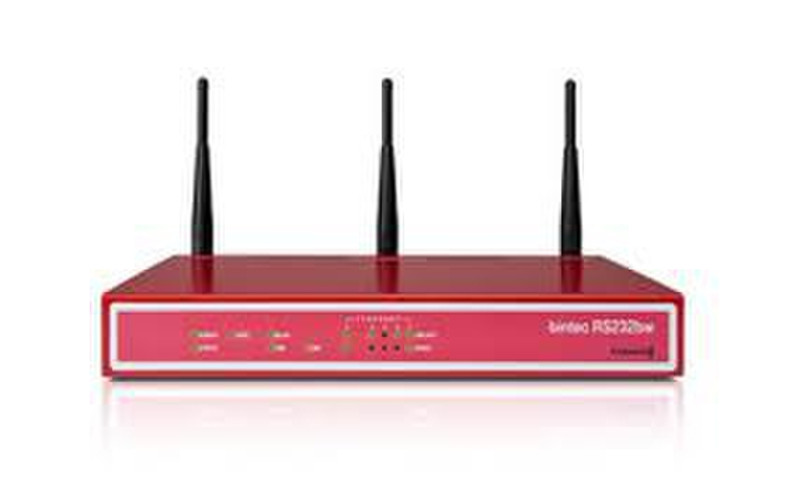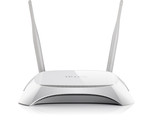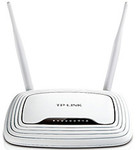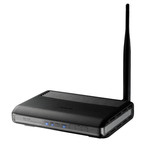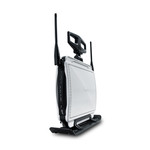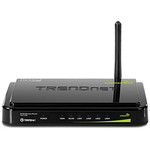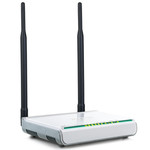目錄的
-
目錄的
- Antiquitäten & Kunst
- Auto & Motorrad: Fahrzeuge
- Baby
- Bücher
- Camping & Outdoor
- Feinschmecker
- Haustierbedarf
- Heimwerken & Garten
- IT和电子
- Kleidung & Accessoires
- Modellbau
- Musik
- PC- & Videospiele
- Sammeln & Seltenes
- Spielzeug
- TV, Video, DVD
- Telekommunikation
- Uhren & Schmuck
- Wellness & Beauty
- fashion & lifestyle
- institutional food services equipment
- medical equipment, accessories & supplies
- 个人护理
- 休闲爱好
- 办公设备,用品和配件
- 商业与工业
- 家居,建筑,装修
- 家用电器
- 摩托车及配件
- 武器和弹药
- 照相机
- 花园和庭院
- 运动,娱乐及休闲
- 食物
- 高保真音響
Filters
Search
Funkwerk RS232bw Gigabit Ethernet Red wireless router
凡购买和价格 (Advertising *)
顶部
技术特点
顶部
联网
| 支持ISDN连接 | Y |
|---|---|
| 接收机灵敏度 | - 2.4 GHz 802.11b/g: 1 Mbps -91 dBm; 2 Mbps -90 dBm; 5.5 Mbps -89 dBm; 11 Mbps -88 dBm; 6 Mbps -90 dBm;9 Mbps -89 dBm; 12 Mbps -88 dBm; 18 Mbps -86 dBm; 24 Mbps -83 dBm; 36 Mbps -80 dBm;\n48 Mbps -76 dBm; 54 Mbps -74 dBm\n- 2.4 GHz 802.11n 20 MHz: MSC0 -89 dBm; MSC1 -87 dBm; MCS2 -85 dBm; MCS3 -82 dBm; MCS4 -79 dBm; MSC5 -75 dBm; MCS6 -73 dBm; MCS7 -70 dBm; MCS8 -83 dBm; MCS9 -84 dBm; MCS10 -81 dBm; MCS11 -79 dBm; MCS12 -80 dBm; MCS13 -72 dBm; MCS14 -68 dBm; MCS15 -67 dBm\n- 2.4 GHz 802.11n 40 MHz: MSC0 -87 dBm; MSC1 -84 dBm; MCS2 -82 dBm; MCS3 -79 dBm; MCS4 -75 dBm; MSC5 -71 dBm; MCS6 -69 dBm; MCS7 -67 dBm; MCS8 -86 dBm; MCS9 -83 dBm; MCS10 -79 dBm; MCS11 -77 dBm; MCS12 -74 dBm; MCS13 -69 dBm; MCS14 -67 dBm; MCS15 -65 dBm\n- 5 GHz 802.11n 20 MHz: MSC0 -88 dBm; MSC1 -85 dBm; MCS2 -83 dBm; MCS3 -81 dBm; MCS4 -78 dBm; MSC5 -74 dBm; MCS6 -72 dBm; MCS7 -70 dBm; MCS8 -88 dBm; MCS9 -85 dBm; MCS10 -83 dBm; MCS11 -80 dBm; MCS12 -77 dBm; MCS13 -72 dBm; MCS14 -70 dBm; MCS15 -68 dBm\n- 5 GHz 802.11a/h: 6 Mbps -88 dBm; 9 Mbps -87 dBm; 12 Mbps -86 dBm; 18 Mbps -84 dBm; 24 Mbps -82 dBm; 36 Mbps -78 dBm; 48 Mbps -74 dBm; 54 Mbps -73 dBm\n- 2.4 GHz 802.11b/g: 1 Mbps 16 dBm; 2 Mbps 16 dBm; 5.5 Mbps 16 dBm; 11 Mbps 16 dBm; 6 Mbps 17,5 dBm; 9 Mbps 17,5 dBm; 12 Mbps 17 dBm; 18 Mbps 17 dBm; 24 Mbps 15 dBm; 36 Mbps 15 dBm; 48 Mbps 13 dBm; 54 Mbps 13 dBm\n- 2.4 GHz 802.11n 20 MHz/40 MHz: MSC0 17.5 dBm; MSC1 17,5 dBm; MCS2 17 dBm; MCS3 17 dBm; MCS4 15 dBm; MSC5 15 dBm; MCS6 13 dBm; MCS7 13 dBm; MCS8 17.5 dBm; MCS9 17.5 dBm; MCS10 17 dBm; MCS11 17 dBm; MCS12 15 dBm; MCS13 15 dBm; MCS14 13 dBm; MCS15 13 dBm\n- 5 GHz 802.11b/g 1 Mbps 16 dBm; 2 Mbps 16 dBm; 5.5 Mbps 16 dBm; 11 Mbps 16 dBm; 6 Mbps 17.5 dBm; 9 Mbps 17.5 dBm; 12 Mbps 17 dBm; 18 Mbps 17 dBm; 24 Mbps 15 dBm; 36 Mbps 15 dBm; 48\nMbps 13 dBm; 54 Mbps 13 dBm\n- 5 GHz 802.11n 20 MHz/40 MHz: MSC0 17.5 dBm; MSC1 17.5 dBm; MCS2 17 dBm; MCS3 17 dBm; MCS4 15 dBm; MSC5 15 dBm; MCS6 13 dBm; MCS7 13 dBm; MCS8 17.5 dBm; MCS9 17.5 dBm; MCS10 17 dBm; MCS11 17 dBm; MCS12 15 dBm; MCS13 15 dBm; MCS14 13 dBm; MCS15 13 dBm |
| 管理协议 | SSL, SSH, HTTP, HTTPS, SNMP, RADIUS, TACACS+ |
安全
| 防火墙 | NAT, PAT |
|---|---|
| 虚拟专用网信道数量 | 5 |
| MAC(媒体存储控制)地址过滤 | Y |
其他功能
| 非操作相对湿度(非冷凝) | 10 - 95% |
|---|---|
| xDSL connection | Y |
| 接口 | miniUSB |
| 网路功能 | Ethernet, Fast Ethernet, Gigabit Ethernet |
| 输入电流 | 1.5 A |
| 频率范围 | 2.4 - 5 GHz |
协议
| DMZ支持 | Y |
|---|---|
| 动态主机配置协议客户 | Y |
| 动态主机配置协议服务器 | Y |
| 支持网络协议 | PPP/MLPPP, DYN DNS |
ADSL的特点
| ADSL说明书 | ADSL: (ITU G.992.1 Annex B, ISDN), G.Lite (ITU G.922.2); ADSL2 (ITU G.992.3, ITU G.992.5 Annex B), ADSL2+ |
|---|---|
| 宽带 | Y |
以太网LAN特性
| 以太网LAN接口类型 | Gigabit Ethernet |
|---|---|
| 以太网的数据传输率 | 1000 Mbit/s |
WAN 广域网连接
| 3G/4G USB 调制解调器的兼容性 | Y |
|---|
天线
| 天线接口类型 | RP-SMA |
|---|---|
| 天线数量 | 3 |
管理功能
| 支持服务质量(QoS) | Y |
|---|---|
| 重启按钮 | Y |
| 网上管理 | Y |
无线局域网的特点
| 调制 | DSSS, OFDM |
|---|
内容包装
| 快速入门指南 | Y |
|---|
端口 & 界面
| DC-IN插口 | Y |
|---|
另外
| 以太网连接器 | Y |
|---|---|
| 以太网路(RJ-45)连接接口数量 | 5 |
Bintec RS232bw - Universal Router with integrated ADSL2+ modem, ISDN & 11n WLAN
The bintec RS232bw is a powerful and, thanks to its comprehensive equipment, flexible router. The integrated ADSL 2+ modem on the RS232b supports Annex B (ADSL over ISDN), which is predominantly used in Germany, in accordance with ITU G992.1 and is compatible with Deutsche Telekom's U-R2 connection.
The router in the fan-free metal housing guarantees long-term reliability in critical corporate applications and is ideal for use as an access router in SMEs, branch offices and home offices. In addition to the integrated ADSL 2+ modem, the device has five Gigabit Ethernet ports, which can be configured for LAN, WAN or DMZ, and comes with a licence for five hardware-accelerated IPSec tunnels. The built-in ISDN BRI interface and the UMTS USB modem connected to the USB port can be used as a remote configuration access and as an ISDN backup interface.
The bintec RS232bw also has a dual band WLAN module with 2.4 and 5 GHz, which supports IEEE 802.11n. The new 802.11n technology permits gross transmission speeds of up to 300 Mbps and offers a better range than the previous 802.11g technology.
Thanks to the integrated IEEE 802.11n compatibility mode, the bintec RS232bw is compatible with all IEEE 802.11g and IEEE 802.11abgh clients and supports the mixed operation of IEEE 802.11n clients and IEEE 802.11b/g or IEEE 802.11a/h clients. This enables the seamless exchange of existing WLAN routers through the bintec RS232bw without significant changes to the infrastructure. Clients that already support 802.11n benefit automatically from the higher data throughput.
Using functions flexibly
Only a few functions are required to forward data packets between two networks. The bintec RS232bw has features that go far beyond just routing and allow it to be integrated into complex IT infrastructures. By using Extended Routing and NAT (ERN) the data can be routed in IP routing according to criteria such as IP protocols (Layer 4), source or destination IP address, source or destination port, TOS/DSCP, source or destination interface and the status of the destination interface. In addition, you can also use network address translation to translate the data traffic for both inbound and outbound connections and individually for each interface based on a wide range of criteria.
The comprehensive multicast support makes the device ideal for use in multimedia and streaming applications.
The Stateful Inspection Firewall (SIF) offers effective protection against attacks from the Internet through dynamic packet filtering. Firewall handling is made easier through numerous pre-configured services. An optional content filter rounds off the security functions of the devices*. In this case, all the outgoing Internet enquiries are classified and allow contents not wanted to be reliably filtered out.
The basic equipment of the RS Series also offers a SIP application level gateway (ALG) for the direct connection of IP telephones in the network or for registering with a VoIP provider, without affecting the security of the WAN connection. The corresponding releases in NAT and the internal Stateful Inspection Firewall are controlled automatically by ALG for the length of the communication.
Quality of Service is more than a watchword in FEC devices. Thanks to the rising convergence between voice and data, the classification of data streams is gaining in importance. Our routers provide corresponding QoS mechanisms for prioritising the VoIP traffic ahead of normal internet traffic, for example, and to guarantee it sufficient bandwidth. Alternatively you can give normal data traffic priority over e-mail traffic. The bintec QoS implementation allows voice data to be processed before e-mal data, for example, within a VPN tunnel.
The DNS proxy function supports the LAN for address implementation and the automated IP configuration of PCs is carried out over an integrated DHCP server.
Remote CAPI is available for the joint use of various ISDN services.
Comprehensive IPSec implementation
The IPSec implementation integrated in bintec RS232bw works not only with preshared keys but also with certificates. This allows a public key infrastructure to be created for maximum security. (The German Federal Office for Information Security also recommends the use of certificates.)
Furthermore, the bintec IPSec implementation offers support when creating VPN connections with dynamic IP addresses: Even small branch offices can be reached without having to be permanently online. If both VPN nodes only have dynamic IP addresses, confidential information can continue. The exchange of IP addresses is carried out either over dynamic DNS providers or directly over ISDN. The actual dynamic IP address is transferred either in the ISDN D-channel (free of charge) or, if this is not possible, in the ISDN B-channel (at cost).
Load Balancing/Backup
The devices offer a unique level of flexibility thanks to the wide variety of interfaces supported. The bintec RS232bw supports the ability to configure two interfaces as WAN interfaces. As a result, there is not only more bandwidth available, but there is the opportunity to spread data traffic across individual WAN connections according to load or data type. Equally, you can use a connection (e.g. SDSL) for the VPN connection to the head office and use a second WAN port for a low-cost ADSL connection to guarantee the company's other data traffic. If either connection fails, the other can take over the entire data transfer. In the event that both lines fail, data traffic can automatically be routed over a UMTS modem connected to the USB port.
Simple configuration and maintenance
The router is configured over the Funkwerk Configuration Interface (FCI), using the integrated configuration wizards for example. The FCI is a web-based graphic user surface that you can use from any PC with an up-to-date Web browser via an HTTP or encrypted HTTPS connection. It also offers the opportunity to manage the devices locally and remotely over other configuration accesses such as Telnet, SSH, ISDN Login and GSM dialin (only possible if USB UMTS modem is connected).
DIME Manager from Funkwerk Enterprise Communications (FEC) is a free tool for managing FEC devices.
Dime Manager is aimed at administrators who manage networks with up to 50 devices. The software simplifies the management and configuration of routers or access points either individually or in logical groups.
When developing DIME Manager, simple and efficient operation was the primary aim. It allows, for example, software updates or configurations to be applied to individual devices or groups of devices simply by drag and drop. DIME Manager recognises and manages new devices in the network using SNMP multicasts, in other words independent of their current IP address.
The router in the fan-free metal housing guarantees long-term reliability in critical corporate applications and is ideal for use as an access router in SMEs, branch offices and home offices. In addition to the integrated ADSL 2+ modem, the device has five Gigabit Ethernet ports, which can be configured for LAN, WAN or DMZ, and comes with a licence for five hardware-accelerated IPSec tunnels. The built-in ISDN BRI interface and the UMTS USB modem connected to the USB port can be used as a remote configuration access and as an ISDN backup interface.
The bintec RS232bw also has a dual band WLAN module with 2.4 and 5 GHz, which supports IEEE 802.11n. The new 802.11n technology permits gross transmission speeds of up to 300 Mbps and offers a better range than the previous 802.11g technology.
Thanks to the integrated IEEE 802.11n compatibility mode, the bintec RS232bw is compatible with all IEEE 802.11g and IEEE 802.11abgh clients and supports the mixed operation of IEEE 802.11n clients and IEEE 802.11b/g or IEEE 802.11a/h clients. This enables the seamless exchange of existing WLAN routers through the bintec RS232bw without significant changes to the infrastructure. Clients that already support 802.11n benefit automatically from the higher data throughput.
Using functions flexibly
Only a few functions are required to forward data packets between two networks. The bintec RS232bw has features that go far beyond just routing and allow it to be integrated into complex IT infrastructures. By using Extended Routing and NAT (ERN) the data can be routed in IP routing according to criteria such as IP protocols (Layer 4), source or destination IP address, source or destination port, TOS/DSCP, source or destination interface and the status of the destination interface. In addition, you can also use network address translation to translate the data traffic for both inbound and outbound connections and individually for each interface based on a wide range of criteria.
The comprehensive multicast support makes the device ideal for use in multimedia and streaming applications.
The Stateful Inspection Firewall (SIF) offers effective protection against attacks from the Internet through dynamic packet filtering. Firewall handling is made easier through numerous pre-configured services. An optional content filter rounds off the security functions of the devices*. In this case, all the outgoing Internet enquiries are classified and allow contents not wanted to be reliably filtered out.
The basic equipment of the RS Series also offers a SIP application level gateway (ALG) for the direct connection of IP telephones in the network or for registering with a VoIP provider, without affecting the security of the WAN connection. The corresponding releases in NAT and the internal Stateful Inspection Firewall are controlled automatically by ALG for the length of the communication.
Quality of Service is more than a watchword in FEC devices. Thanks to the rising convergence between voice and data, the classification of data streams is gaining in importance. Our routers provide corresponding QoS mechanisms for prioritising the VoIP traffic ahead of normal internet traffic, for example, and to guarantee it sufficient bandwidth. Alternatively you can give normal data traffic priority over e-mail traffic. The bintec QoS implementation allows voice data to be processed before e-mal data, for example, within a VPN tunnel.
The DNS proxy function supports the LAN for address implementation and the automated IP configuration of PCs is carried out over an integrated DHCP server.
Remote CAPI is available for the joint use of various ISDN services.
Comprehensive IPSec implementation
The IPSec implementation integrated in bintec RS232bw works not only with preshared keys but also with certificates. This allows a public key infrastructure to be created for maximum security. (The German Federal Office for Information Security also recommends the use of certificates.)
Furthermore, the bintec IPSec implementation offers support when creating VPN connections with dynamic IP addresses: Even small branch offices can be reached without having to be permanently online. If both VPN nodes only have dynamic IP addresses, confidential information can continue. The exchange of IP addresses is carried out either over dynamic DNS providers or directly over ISDN. The actual dynamic IP address is transferred either in the ISDN D-channel (free of charge) or, if this is not possible, in the ISDN B-channel (at cost).
Load Balancing/Backup
The devices offer a unique level of flexibility thanks to the wide variety of interfaces supported. The bintec RS232bw supports the ability to configure two interfaces as WAN interfaces. As a result, there is not only more bandwidth available, but there is the opportunity to spread data traffic across individual WAN connections according to load or data type. Equally, you can use a connection (e.g. SDSL) for the VPN connection to the head office and use a second WAN port for a low-cost ADSL connection to guarantee the company's other data traffic. If either connection fails, the other can take over the entire data transfer. In the event that both lines fail, data traffic can automatically be routed over a UMTS modem connected to the USB port.
Simple configuration and maintenance
The router is configured over the Funkwerk Configuration Interface (FCI), using the integrated configuration wizards for example. The FCI is a web-based graphic user surface that you can use from any PC with an up-to-date Web browser via an HTTP or encrypted HTTPS connection. It also offers the opportunity to manage the devices locally and remotely over other configuration accesses such as Telnet, SSH, ISDN Login and GSM dialin (only possible if USB UMTS modem is connected).
DIME Manager from Funkwerk Enterprise Communications (FEC) is a free tool for managing FEC devices.
Dime Manager is aimed at administrators who manage networks with up to 50 devices. The software simplifies the management and configuration of routers or access points either individually or in logical groups.
When developing DIME Manager, simple and efficient operation was the primary aim. It allows, for example, software updates or configurations to be applied to individual devices or groups of devices simply by drag and drop. DIME Manager recognises and manages new devices in the network using SNMP multicasts, in other words independent of their current IP address.
類似的優惠
顶部
-
支付方式
我们接受:



